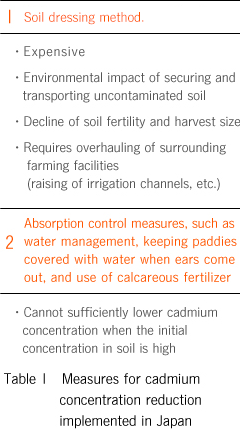Chemical cleaning method
for a cadmium contaminated paddy field
| >Introduction | >Overview and Features | >Key Technology Points | >Costs and Benefits |
Introduction
Cadmium is a heavy metal which has been scattered widely throughout nature through water and air pollution. This pollution was the result of the disposal of waste products from industrial activities, by mines, refining plants, and the like. As a result, many crops contain trace amounts of cadmium. Excessive cadmium, ingested over a long period of time, can impair kidney functions. The amount of cadmium ingested through regular Japanese food products is considered unlikely to have any health effects, but further reducing cadmium intake is advisable.
Recently, the Codex Alimentarius Commission (joint WHO and FAO food standards programme) established standard values for cadmium in foods such as rice, based on a risk evaluation of cadmium absorbed from food. In step with these international efforts, Japan's Food Sanitation Act, enacted on April 8, 2010, also revised rice cadmium standard values from "less than 1.0mg/kg" to "0.4mg/kg or under". This new value went into effect from February 28, 2011.
The two methods at right have been used nationwide to reduce the concentration of cadmium in rice, but each of their methods have their own drawbacks. (See Table 1)
This technology solves the issues faced by these conventional methods, and can be implemented inexpensively. It is also more environmentally friendly than conventional methods, offers greater heavy metal removal efficiency, and also has the advantage of continuing subsequent effects.it has been expected as one of the measures to clear the new standards.
Recently, the Codex Alimentarius Commission (joint WHO and FAO food standards programme) established standard values for cadmium in foods such as rice, based on a risk evaluation of cadmium absorbed from food. In step with these international efforts, Japan's Food Sanitation Act, enacted on April 8, 2010, also revised rice cadmium standard values from "less than 1.0mg/kg" to "0.4mg/kg or under". This new value went into effect from February 28, 2011.
The two methods at right have been used nationwide to reduce the concentration of cadmium in rice, but each of their methods have their own drawbacks. (See Table 1)
This technology solves the issues faced by these conventional methods, and can be implemented inexpensively. It is also more environmentally friendly than conventional methods, offers greater heavy metal removal efficiency, and also has the advantage of continuing subsequent effects.it has been expected as one of the measures to clear the new standards.





